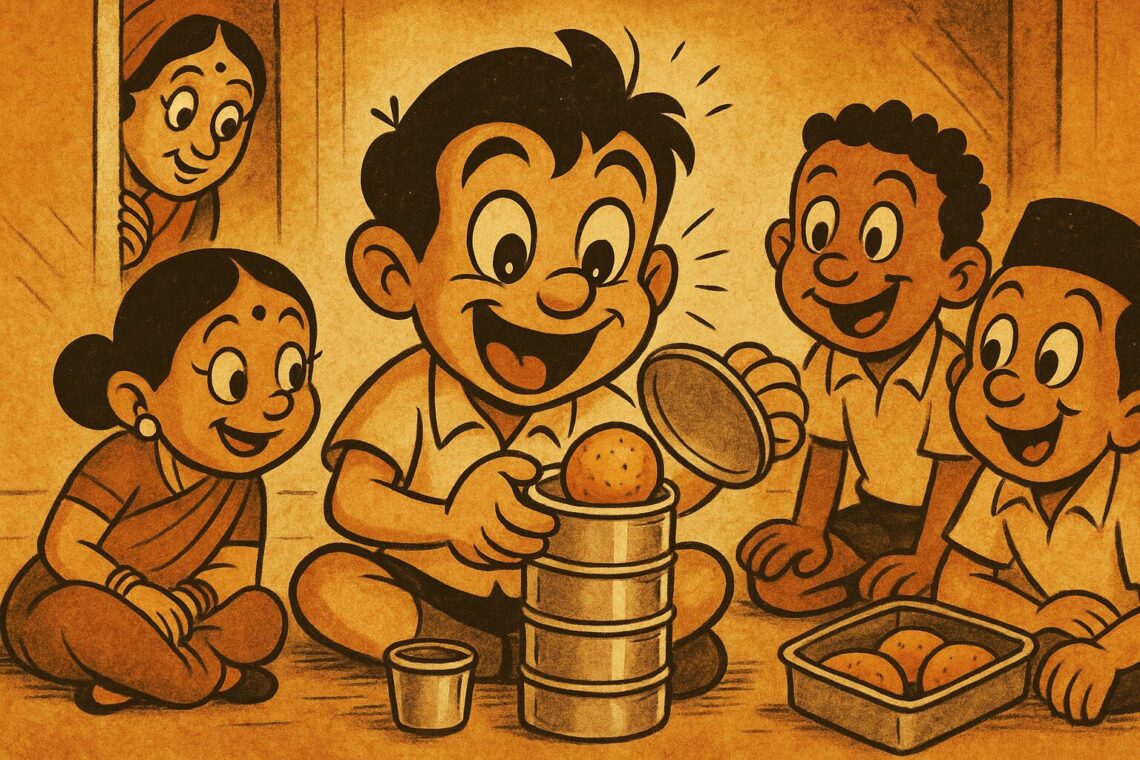My mother’s tiffin was a stainless-steel totem pole. Four-tiered. Clasped tighter than my childhood secrets. Each dabba had a designated purpose: roti in the top, sabzi below, rice and dal layered in perfect thermal intimacy. But there was one tier—always the smallest, tucked into the bottom like an afterthought—that held mysteries. The “bonus round,” as my sister and I used to call it. Because that’s where the unexpected lived.
Sometimes it was a sneaky piece of mysore pak. Sometimes it was what my mom called “just salad,” which meant grated carrot and a sprinkle of chaat masala that made it technically not a punishment. And sometimes—on days when she suspected my mood, or simply wanted to mess with me—it held what I now refer to as “passive-aggressive health food.” A single wedge of boiled lauki with cumin, staring up at me like a disappointed parent. Message received.
The Architecture of a Tiffin
Indian tiffins aren’t just containers. They’re containers with character. Every layer has a role. The big ones are predictable. The rice tier is roomy, reliable, slightly stained with turmeric around the edges. The dal tier leaks if not respected. The roti box always smells faintly of ghee and longing. But it’s the last one—the smallest compartment—that holds drama. It’s the wildcard. The plot twist. The Ferrero Rocher of lunch reveals.
My mom denied this categorization. “It’s just what fit,” she’d say. But I knew better. That last box had intention. It was where she snuck in the thing she wanted me to eat, but knew I’d never ask for. One shriveled date. One imli candy. Half a paratha from breakfast, still heroic. A chunk of paneer that somehow tasted like it had been blessed by her.
Contraband and Emotional Bribery
When I got to college, I started packing my own tiffin. Which meant the bottom tier stayed empty. I didn’t need surprise fruit. I wasn’t twelve. But one afternoon, during a long economics lecture, I opened my dabba to find a square of sooji halwa wrapped in foil. I hadn’t packed it. I looked around, confused. Then I remembered—my mom had visited the night before and casually said, “I put something small for tomorrow.”
That something small made me cry a little. Right there. Between graphs of inflation and demand curves, I had my very own emotional meltdown, courtesy of a mother who understood the economics of comfort food better than any syllabus ever could.
The Psychology of the Secret Box
Years later, when I moved to Austin and started packing lunch for work, I bought a sleek, microwave-safe bento box with separate compartments. Everything stayed neat, and nothing leaked. But it had no soul. No secrets. No sense of “let’s see what’s at the bottom.” So I went back to a small, two-tier steel tiffin I found at an Indian grocery store. And yes, I use the bottom tier for surprises. Not always for myself—sometimes for my son. A single jeera biscuit. A mini sandwich. One grape. One extremely hopeful grape.
He hasn’t noticed yet. But one day, he will. One day, that secret compartment will be opened like a tiny drawer of delight. And maybe, if I’m lucky, he’ll think of me the way I think of my mom—part magician, part nutritionist, full-time emotional engineer.
That Tier Still Matters
I went home recently and saw my mother packing my dad’s tiffin. Same old stack. Same quiet mastery. And there it was—the bottom box. She filled it with a small besan laddoo, closed the lid, and said, “He’ll complain it’s too sweet, but he’ll eat it.”
That’s the secret of the secret compartment. It’s not about the food. It’s about the whisper. The wink. The edible nudge that says, “I see you. I’m thinking of you. Even after three rotis and one aloo sabzi, you deserve something just because.”
We talk a lot about love languages. I’m convinced that for Indian parents, the final tier of a multi-level tiffin is one of them. Equal parts surprise, subtext, and soft power. Always waiting. Always closing the meal with something you didn’t know you needed.
Born in Mumbai, now stir-frying feelings in Texas. Writes about food, memory, and the messy magic in between — mostly to stay hungry, sometimes just to stay sane.












